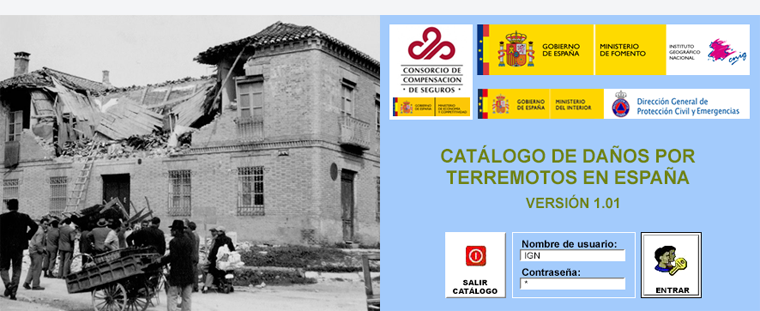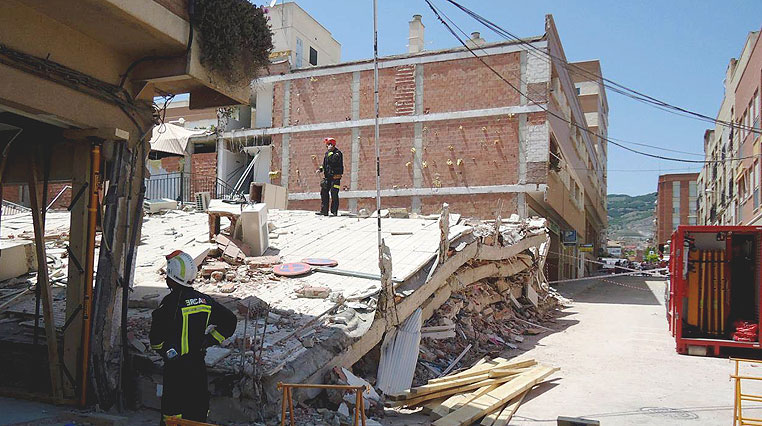
In early 2015 the Directorate-General for Civil Protection and Emergencies (DGPCE), the National Geographic Institute (IGN), the National Centre for Geographic Information (CNIG) and the
Consorcio de Compensación de Seguros (CCS), which are public institutions that have a long track record of mutual cooperation, took the first steps towards undertaking a new joint project that materialised in the form of a partnership agreement on 7 May 2015 with the objective of compiling a Catalogue of Earthquake Damage in Spain (CDTE).
The project seeks to create a tool to set up a single database to reflect the damage caused by earthquakes in Spain. A database of this kind is in harmony with the most recent trends in disaster risk reduction as established under the Sendai Framework for Disaster Risk Reduction 2015-2030. This framework makes it a priority to
understand disaster risk through systematically evaluating, logging, sharing and making the public aware of the loss caused by disasters. In this way it becomes possible to understand the economic, social, health, educational, environmental and cultural heritage impact within the context of information on the vulnerability and level of exposure arising from threats in relation to specific events.
At the same time, through its Joint Research Centre (JRC) and the Directorate-General for European Civil Protection and Humanitarian Aid Operations (DG ECHO), the European Commission set up a group of experts in November 2013 to examine how data on loss and damage from disasters is recorded in the European Union and to recommend best practices and guidelines. This group comprises representatives from the member states, the private sector, academic and scientific institutions, and international organisations, as well as staff from the services provided by the European Commission. Spain has been represented in this group almost right from its establishment by the Natural Risks Section of the DGPCE. Pursuant to the goals established by this working group, the JRC has published the following guides:
- Recording Disaster Losses: Recommendations for a European Approach (2013).
- Current Status and Best Practices for Disaster Loss Data Recording in EU Member States: a comprehensive overview of current practice in the EU Member States (2014).
- Guidance for Recording and Sharing Disaster Damage and Loss Data: Towards the development of operational indicators to translate the Sendai Framework into action (2015).
The DGPCE brought its experience in compiling and keeping the National Historical Flood Catalogue (CNIH) to this project, which is a record that has been kept since 1995 and systematically collates data on historical floods in Spanish territory. A catalogue of this kind is useful for logging damage that has occurred, identifying and classifying zones that are potentially under threat from flood risk, and writing up a catalogue of action to take should new incidents arise. The CNIH is therefore the direct precursor of the CDTE (Catalogue of Earthquake Damage in Spain). At the same time, through its involvement among the group of European experts, the DGPCE ensures that the latest guidelines and best practices are transposed to the CDTE.
Among its functions, the IGN (National Geographic Institute) attends to the planning and management of systems to detect and report seismic movements that occur on Spanish territory and in surrounding areas, as well as making studies of seismicity and coordinating norms aimed at resisting earthquake activity, in addition to its role of providing the official geographic information in Spain. In this regard, the IGN has contributed to the project with a list of earthquakes to include in the catalogue along with the available reference information on them.
The CNIG (National Centre for Geographic Information) is an Autonomous Body of the Government of Spain attached to the Ministry of Public Works via the IGN. One of its purposes is to produce and pursue projects of a geographic nature that society requires, with a particular focus on carrying out initiatives based on advanced technology, research and development programmes, and providing technical assistance within the sphere of geographic sciences and techniques. Thus, its role in relation to the CDTE has involved supplying technical and human resources, including outsourcing services to set up a database and record information.
Earthquakes account for roughly 8% of all extraordinary risk insurance pay-outs made by the CCS (
Consorcio de Compensación de Seguros) over the past 30 years, representing a figure of in excess of 500 million euros in today’s money. Besides running the extraordinary risk insurance scheme, the function of CCS include drawing up plans and programmes to prevent and reduce loss and developing these via relevant campaigns and preventive measures. Due to all this, in addition to contributing with its loss register of earthquake damage caused to insured property, CCS has funded the entire CDTE project.
In its current phase, the project came to an end in December 2016. It enabled a database to be designed by following the methodology used for the CNIH and adapting this to seismic risk, as well as incorporating aspects relating to the recording of data on catastrophe damage and loss as covered in the above-mentioned JRC guidance for recording and sharing disaster damage.
At present there is a complete methodology available to characterise all of the elements that make up the earthquake damage database and a tool that allows them to be catalogued, recorded and used, all of which means that the problem of having various incomplete databases at separate institutions can be overcome.
The monitoring committee under the agreement to put together the CDTE comprises representatives of the cited institutions taking part and at one of its first meetings it took the decision to include all earthquakes in the CDTE that satisfy these two conditions:
- Their seismic intensity should be greater than or equal to VI (EMS-98).
- They have to have caused damage in Spain, even if their epicentre does not lie within Spanish territory.
This means that, according to the earthquakes recorded in the IGN’s Seismic Catalogue, the CDTE should, at the present time, contain 772 events, 337 of which had epicentres within Spanish territory (44%). Aside from the official designing and commissioning of the tool, some 120 earthquakes out of these 772 were recorded in trials of the application.

Given that the overriding objective of the CDTE is to catalogue all the damage caused by earthquakes in Spain, the information it covers has been grouped into two broad blocks according to content. The first block, named
general data, features information on the seismic data, and the sources and documentation on the event. The second,
damage by municipality, offers the data available on personal injury and damage to households, infrastructure, agriculture and livestock, industry, basic services, and equipment that is caused by each event.
The main characteristics of the CDTE database are shown in the table below:

